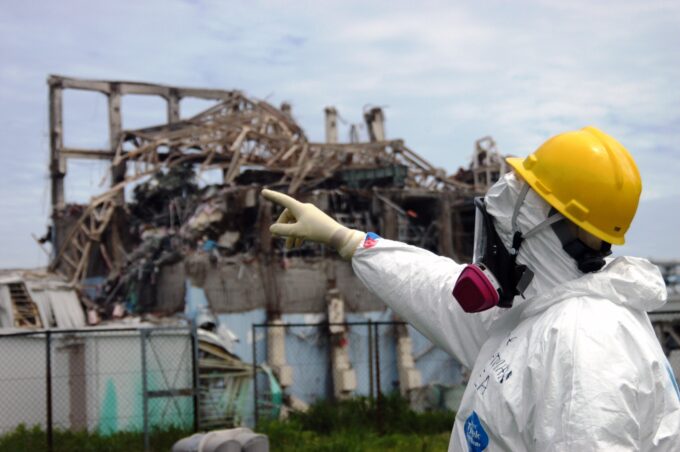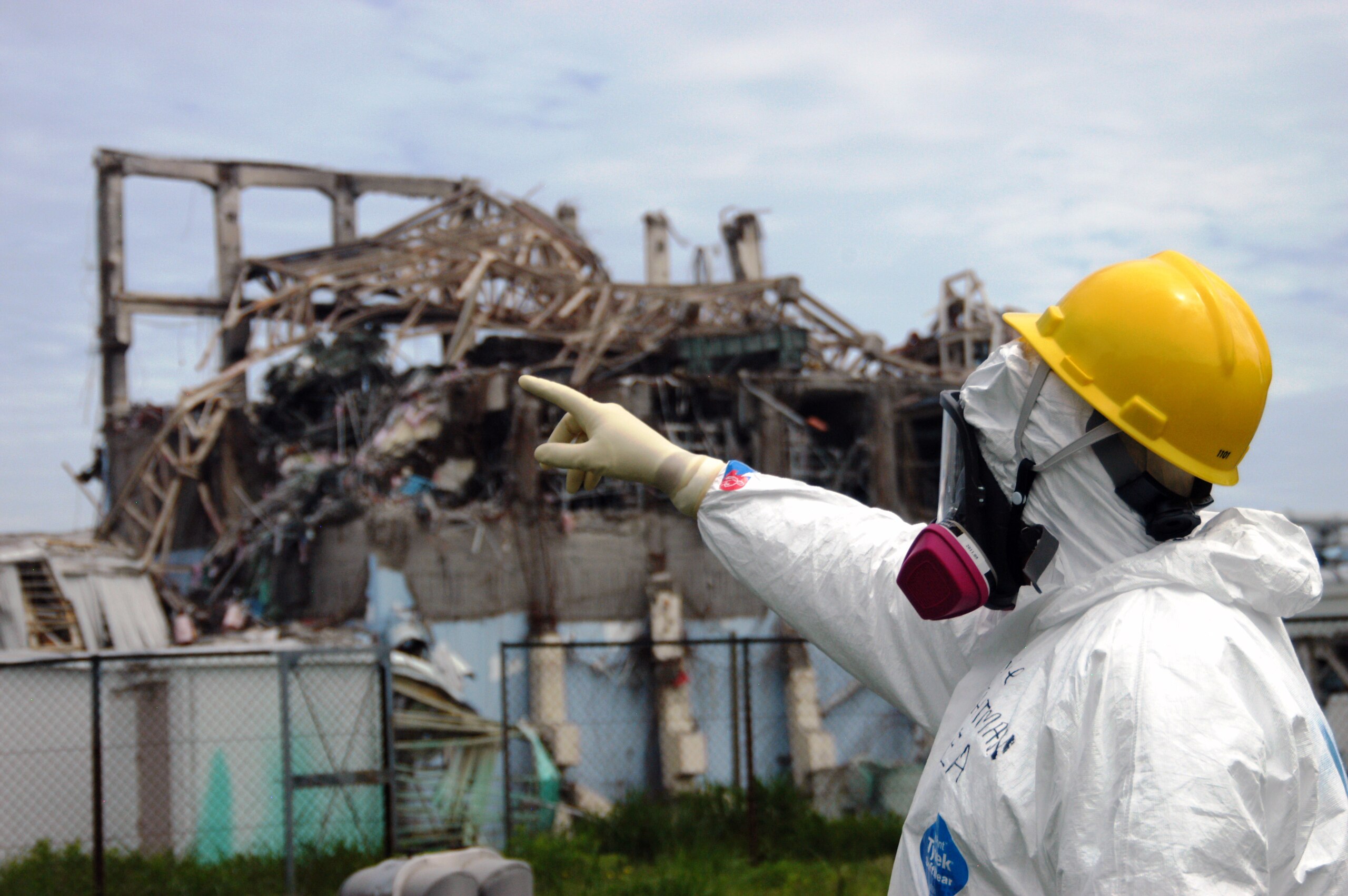






























































Photograph Source: IAEA Imagebank – https://www.flickr.com/photos/iaea_imagebank/5765324940/ – CC BY-SA 2.0
The dispersal of radioactive wastewater from the Fukushima-Daiichi reactor disaster site to the Pacific Ocean is “in line with international safety standards” according to a task force set up by the International Atomic Energy Agency (IAEA), the UN’s nuclear power advocacy program, in a December 24, 2024 report.
Ever since the Tokyo Electric Power Co., or Tepco, first proposed pumping wastewater left from cooling Fukushima’s three hot piles of melted reactor fuel into the Pacific, the IAEA has supported, encouraged, and endorsed the plan, in spite of its own formal published guidelines which advise against it.
In June 2023, Dr. Arjun Makhijani of the Institute for Energy and Environmental Research, published a scathing critique of the IAEA’s approval, finding the oceanic pollution violates essential provisions of the agency’s own General Safety Guide.
The IAEA’s first 2023 report on the dumping scheme said the plan was “consistent” with its standards, and it claimed even before the first major release of the radioactive water that it would have a “negligible radiological impact to people and the environment.” Now the IAEA’s onsite laboratory in Japan has analyzed the first ten discharges that have been conducted between August 2023 and October 2024, Nuclear Engineering International reported.
The bulk of the radioactivity in the wastewater being pumped into the ocean is from tritium, the radioactive form of hydrogen, and carbon-14, neither of which can be filtered from water they contaminate. However, analyses of 1.3 million tons of waste coolant now stored in tanks shows a complex mix of other highly radioactive isotopes, including strontium-90, cesium-134 and -137, cobalt-60, americium, technetium, and even tellurium-127. In 2018, Tepco apologized for the failure of its giant filter system to separate all the materials it promised to, and has said it would repeatedly re-filter the contaminated water to try and remove 62 different reactor-borne isotopes before dumping it into the world’s largest ocean.
IAEA approval is license to copy bad actors
Japan’s oceanic radioactive pollution was supposed to have been banned with the 1972 Convention on the Prevention of Marine Pollution by Dumping of Wastes and Other Matter. This monumental international law against disposing of hazardous and radioactive wastes at sea prohibits dumping “from vessels, aircraft, platforms or other man-made structures.”
Yet the use of major undersea pipelines at Fukushima-Daiichi in Japan, at La Hague in France, and at Sellafield in the UK have been granted exemptions — as if the massive pumping systems were not “man-made.” On a yearly basis, the La Hague plutonium processing system discharges some 1.4 million barrels worth of liquid radioactive waste into the North Sea, Greenpeace reports.And the UK’s Sellafield site pumps 24 million barrels of radioactive liquids into Irish Sea every year.
When the IAEA says that Japan’s ocean dumping is “in line with international safety standards,” this is the globalized radioactive polluting that is being referenced and endorsed.
Radioactive soil to be spread nationwide as construction fill
In spite of obvious risks to workers who handle it and the threat of surface water contamination caused by rain runoff and winds, the Japanese government has approved plans to allow 14-million metric tons of radioactive soil — and 300,000 metric tons of radioactive ash from incinerators — to be used in public works projects like road and railway construction, and even agriculture “nationwide,” according to the international news reports.
The government calls the plan “recycling,” and it’s been consistently opposed by critics who point to federal regulations that forbid any use of radioactive materials that are contaminated with more than 100 becquerels of cesium-137 per kilogram (Bq/kg). Waste that’s “hotter” must be disposed of as radioactive waste.
Yet the government intends to allow the use of soil (scraped from thousands of square kilometers that were hit with fallout from the three meltdowns) containing up to 8,000 Bq/kg of cesium, 80 times the federal limit. Radioactive cesium was spewed in large quantities from the triple meltdowns of March 2011 and it persists in the environment for up to 300 years. (Mountain forests in the fallout zones west of Fukushima cannot have topsoil removed and so remain contaminated with cesium which is spread downhill by heavy rains.)
Watchdogs with the Citizens Nuclear Information Center in Tokyo point out that government rules would be violated if the 8000 Bq/Kg limit is allowed. Yumiko Fuseya wrote in CNIC’s newsletter, “Despite the Nuclear Reactor Regulation Act stating that only waste of 100 Bq/kg (becquerels/kilogram) or less can be recycled, [the plan says] ‘removed soil’ of up to 8,000 Bq/kg can be recycled, and this is a double standard.”
Fuseya complained that Japan’s Ministry of Environment, “claims that ‘disposal’ includes ‘recycling,’ even though Article 41 of the Act on Special Measures Concerning the Handling of Materials Contaminated by Radiation does not include ‘recycling.’
The daily Yomiuri Shimbun reported December 5 that about 75% of some 14 million tons of bagged soil has a radioactive cesium count of 8,000 becquerels or less per kilogram.
CNIC also reports that the government has conducted hair-raising agricultural experiments in Fukushima Prefecture, such as growing and harvesting cucumbers and radishes “in fields where the [contaminated] soil has been covered with normal soil.”
Just as the International Atomic Energy Agency has approved of dispersing contaminated wastewater into the Pacific Ocean, the agency last September gave final approval to Japan’s plan for using the radioactive soil and fly ash (now piled in 14 million 1-tonne bags) for public works projects, saying that the scheme is “consistent with IAEA safety standards.”
Ongoing earthquakes & aftershocks
As if accidents with wastewater pumping, Pacific Ocean poisoning with radioactive wastewater, and spreading millions of tons of cesium-tainted soil around the public commons weren’t hazardous enough, routine earthquakes and their aftershocks off northeast Japan relentlessly rock the Fukushima disaster site and threaten to crack open giant tanks now holding 1.3 million tons of highly radioactive wastewater. Relentlessly frequent quakes also endanger the means of water cooling the 880 tons of molten reactor fuel (or ‘corium’) still thermally hot and radioactively unreachable somewhere beneath the three smashed reactors.
On January 23, after a 5.2 magnitude quake hit the Fukushima Prefecture’s Aizu area, the government warned of possible aftershocks and urged people to “stay vigilant” against landslides and avalanches. Last April 4, a 6.1 magnitude quake rattled Fukushima’s coastline just 47 miles off the site of the three meltdowns — far closer than the super quake of March 2011, the biggest in Japan’s recorded history, which was 80 miles offshore.
Clean-up workers increasingly fear contamination
Following a string of clean-up related radiation accidents at the devastated station, Tepco workers have grown more concerned about their safety. The daily Asahi Shimbun reports that a Tepco survey its workers found that over 40 percent of the workforce was worried about jobsite “radiation issues.” Of this group, 52% said “physical contamination” was their main concern, seven percentage points higher than its 2023 survey. Tepco said that the repetition of exposure accidents on site have likely increased workers’ worries.
In October 2024, two workers were hospitalized after being splashed with highly radioactive liquid wastes bursting from a hose that disconnected inside a wastewater treatment building. And in February 2024, about 5.5 cubic meters, or 5.5 metric tonnes, of highly radioactive liquid waste gushed from the a “cesium absorption apparatus” in an incinerator building before a worker noted it and closed a valve.
The Citizens Nuclear Information Center in Tokyo keeps close track of the routine accidents taking place at Fukushima and across Japan’s nuclear industry here.
New documentary: “Unfogging Fukushima”
The China Global Television Network (CGTN) has produced an English language documentary on the three simultaneous reactor meltdowns and their massive radioactive releases which premiered December 31, 2024.
The network announced the debut noting, “Despite extensive efforts over the past 13 years, problems such as discharging nuclear-contaminated water into the sea still exist. CGTN visited the worst-hit area, measured nuclear radiation, and investigated the truth behind the enduring consequences of the accident.” The film is available here.
The post Fukushima Pollution Solution: Spread Radioactivity Far and Wide appeared first on CounterPunch.org.
This post was originally published on CounterPunch.org.